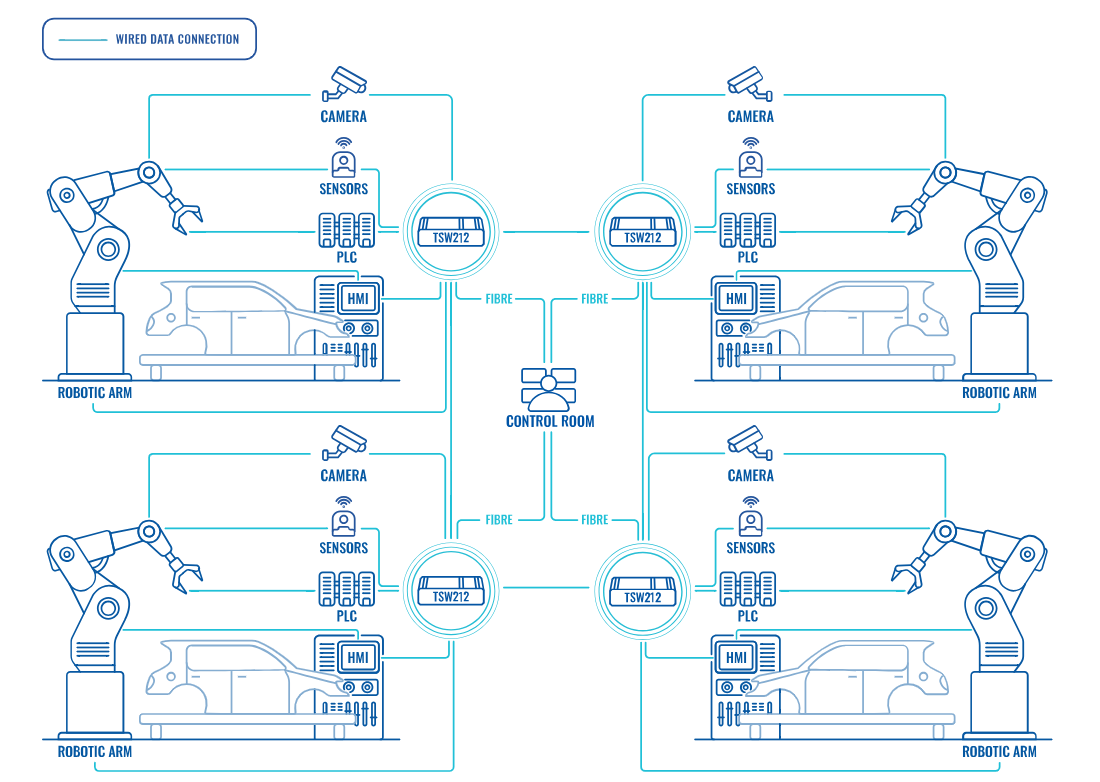MANAGED SWITCH FOR SUPERIOR CAR MANUFACTURING PRECISION
Last updated: 17 พ.ย. 2566 | 463 จำนวนผู้เข้าชม |

HIGHLIGHTS
✔ Car manufacturing facilities can achieve utmost performance primarily through automation. Their equipment demands robust network connectivity, but must also be continuously and precisely controlled and monitored at all times.
✔ The TSW212 managed switch is the puzzle piece completing this challenge, seamlessly integrating all facility equipment into one cohesive system and providing granular network management through its port management and QoS features.
✔ With support of protocols like EtherNet/IP, Profinet, and MRP, this managed switch facilitates automated data processing and supports MRP systems for establishing ring topologies between devices, which are essential for reducing the risk of production delays to the minimum.
THE CHALLENGE – THE COMPLEX WEB OF MANUFACTURING EQUIPMENT
Car manufacturing facilities often resemble scenes from the “Where’s Waldo?” puzzle book, as they’re always filled to the brim with diverse equipment that demands non-stop meticulous management as well as supervision.
With a staggering global production of 85 million vehicles in 2022 alone, it is evident that the control and oversight of such immense manufacturing capacities cannot rest solely on human shoulders. Automation is a must.
A car assembly line relies on a complex web of sensors, cameras, robotic arms, and a programmable logic controller (PLC) to ensure that vehicles roll off the line without any substandard surprises. Any failure of these devices to quickly signal a halt in the manufacturing process can lead to costly production delays, wasted time, and inefficiency.
Considering the sheer amount of equipment involved in vehicle manufacturing lines, automation of these facilities must be thoroughly planned and executed to uphold high-speed and precision-driven manufacturing processes.
While it’s well-known that all these end devices require network connectivity to operate seamlessly, it's equally crucial to recognise that each equipment requires granular control, has different data transmission priorities, and, most importantly, must uphold imperative M2M communication.
Enabling this amount of control in networking solutions is beyond the reach of unmanaged switches. But guess what can rise to the challenge? The Teltonika Networks TSW212 managed switch.
TOPOLOGY

THE SOLUTION – A MANAGED SWITCH TO SAVE YOU FROM THE WEB
The TSW212 managed switch is exactly what this challenge calls for. It’s an 8-port managed switch that’s been specifically created to act as a reliable intermediary, transmitting precise data across a diverse range of equipment. It provides exceptional control over each device’s function and performance within the networking solution’s ecosystem. But let’s see in greater detail how this looks in practice.
This managed switch is notorious for its port management and QoS services. These allow you to reduce latency, give priority to essential data, and allocate more bandwidth to robotic arms and PLCs, ensuring they promptly report their status. Additionally, features like port mirroring and isolation enhance the system’s efficiency by enabling network segmentation and assured data transmission, which improves overall efficiency and data flow.
With its built-in din rail mount, the switch can be effortlessly affixed anywhere along the manufacturing lines, allowing flexible adaptation to network infrastructure needs. So by installing multiple TSW212 managed switches throughout the facility, you can seamlessly interconnect every switch with each assembly line cameras, proximity sensors, position sensors, quality control devices, HMIs, robotic arms, and PLC. All within a unified system using Ethernet ports.
To establish access to all managed switches and end devices, a high-speed fibre optic cable can be used to interconnect this infrastructure with the control room, ultimately enabling granular management capabilities across all endpoints.
The TSW212 managed switch supports an array of industrial protocols, like EtherNet/IP, Profinet, and MRP, to ensure that the vast majority of industrial equipment can instantaneously exchange data with each other. This is vital for when you must ensure the highest-level efficiency of your solution.
The EtherNet/IP protocol enables real-time communication capabilities and facilitates the integration of all facility equipment into a single network. This protocol forms the essential infrastructure for achieving the desired level of M2M communication, which is a significant step towards enhancing the overall efficiency of the car manufacturing facility.
The Profinet protocol functions as a facilitator for each end device to rapidly integrate and synchronise data exchange between each robotic arm so that they all perform with the greatest precision and accuracy. Profinet also enables you to configure automated data processing, which minimises human errors, ensures consistent data readings and analytics, and streamlines compliance with industry regulations as well as reporting requirements.
The prowess of the Profinet protocol becomes evident when position sensors installed along robotic arms quickly check and ensure accurate movement and alignment, simultaneously sending this data to the PLC.
If a robotic arm deviates from its predefined movement paths, the position sensor instantly relays this information to the PLC. In response, the PLC commands the robotic arm to stop until control room administrators address the issue. This level of automated data processing truly represents precision like never before.
Importantly, playing a significant role in this solution is the MRP protocol, facilitating MRP systems between TSW212 managed switches. This protocol establishes a ring topology among the Ethernet switches, allowing for automatic rerouting of data transmission if one managed switch goes offline or is in a rebooting stage. With MRP systems, you’re granted continuous network connectivity across the entire setup, which is vital for networking solutions like this one.
The TSW212 managed switch offers multiple benefits: from port management and QoS services to supporting vital protocols for industrial applications that enable automated data processing and ring topologies. Simply put, this managed switch encompasses everything such a challenge might require.
